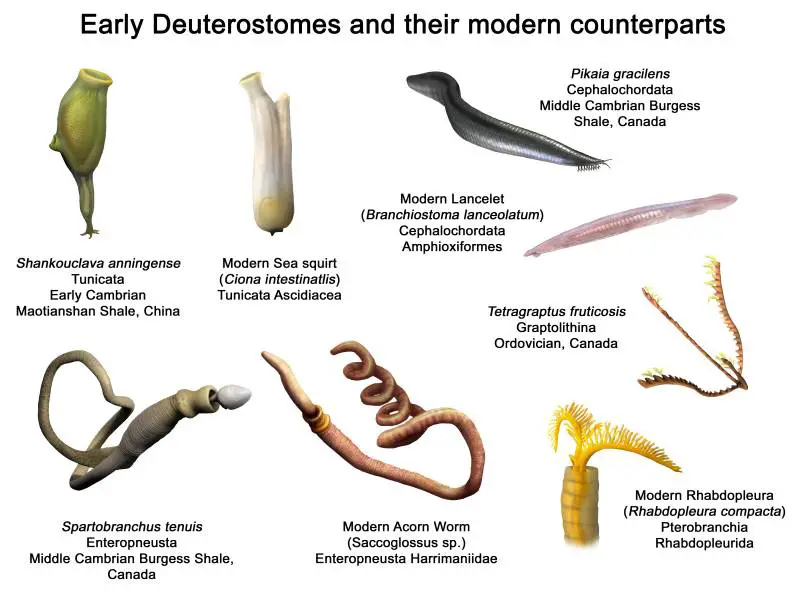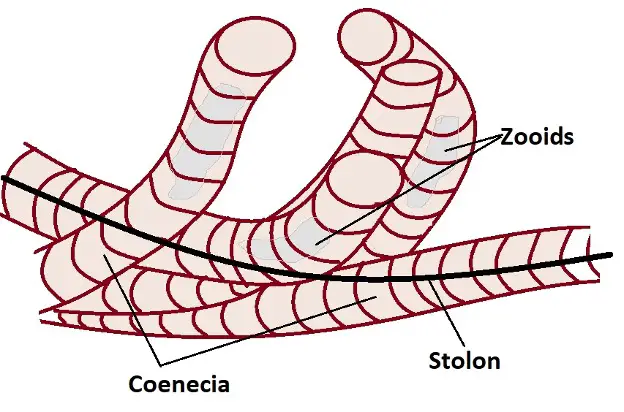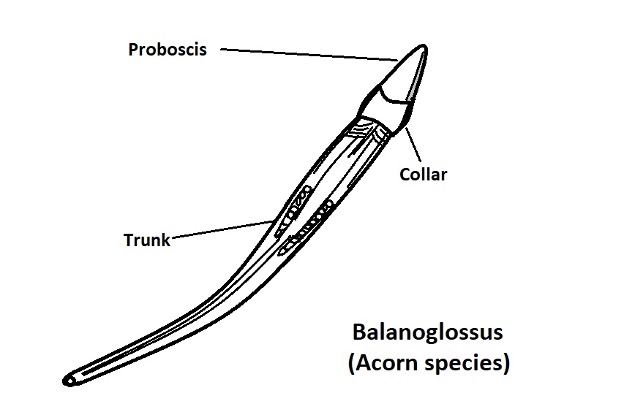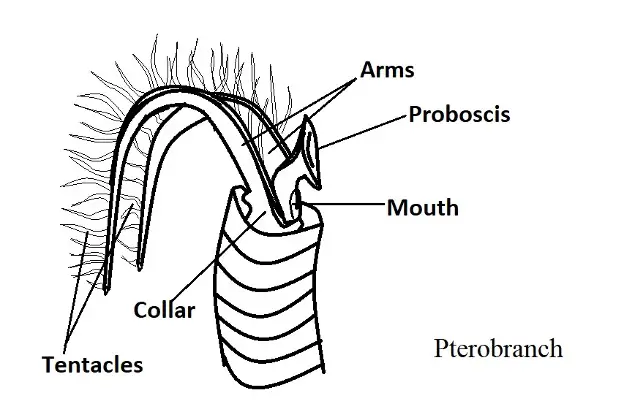Phylum Hemichordata
Examples and Characteristics
The Phylum Hemichordata consists of worm-like organisms collectively known as Hemichordates (currently estimated to have about 130 members). In some literature, Hemichordata is classified as a subphylum of the Phylum Chordata. However, it's a distinct phylum closely related to echinoderms. The group is divided into two main classes which include Pterobranchia and Enteropneusta.
* Hemichordata are also known as half-chordates or pre-chordates.
* They vary in from pink and yellow to brown.
* They also greatly vary in size from 0.6 mm (e.g. Meioglossus psammophilus) to over 1.5 meters (e.g. Balanoglossus gigas).
Some species of the Phylum Hemichordata include:
· Ptychodera flava
· Saccoglossus bromophenolosus
· Cephalodiscus gracilis
· Rhabdopleura normani
· Balanoglossus
* Hemichordata means "half Chordata". Unlike Chordates, Hemichordates have a stomochord that extends from the pharynx to the proboscis. However, this does not mean that they are a subphylum of Phylum Chordata.
* The name Hemichordata was coined by the English biologist, William Bateson in 1885. It was not until 1974 that members of this group were placed as a separate phylum by Robert Barnes.
Characteristics of phylum Hemichordata
Distribution and Habitat
Like some Chordates, Hemichordates are marine organisms. They are widely distributed and can be found in oceans throughout the globe. While they are all marine invertebrates, they can be found in different habitats in this environment.
For instance members of the class Enteropneusta (also known as Acorn worms) are commonly found along the seashore and shallow marine areas where they live in U-shaped burrows (E.g. Balanoglossus clavigerus and Saccoglossus ruber use their muscular proboscis to form burrows in mud or soft sand). However, some of the species can be found living under objects like shells and stones or in depths of up to 10,000 feet where they swim freely.
Members of the class Pterobranchia, on the other hand, are commonly found in the deeper parts of ocean waters where they live in secreted tubular structures known as coenecia. The majority of species can be found in the Southern Hemisphere and live as suspension feeders.
* Members of the genera Rhabdopleura and Cephalodiscus are some of the species capable of forming coenecia. These are nonchitinous tubes that are typically secreted by the cephalic tube. These structures vary in shape and size and may be linked by a stolon.
* Each coenecial cavity may be inhabited by a colony of up to 15 zooids joined together.
Anatomy
Hemichordates in phylum Hemichordata are worm-like, soft-bodied invertebrates. Their bodies (which are cylindrical and elongated) are divided into three main parts which include the collar, a trunk, and a proboscis. The proboscis is located at the anterior part of the body. In Enteropneusts, the proboscis is short with a conical projection.
In Pterobranchs, however, it's expanded with a shield-like appearance. In Pterobranchs, the tube-like structure is secreted from parts of the proboscis. The part between the proboscis and the trunk is known as the collar. In acorn species (Enteropneusts), the collar is a simple ring-like section posterior to the proboscis.
For Pterobranchs, the collar consists of several arm-like ciliated tentacles (2-9 arms). Lastly, the trunk forms the posterior part of these organisms. It is U-shaped in Pterobranchs and contains the majority of internal organs.
Proboscis
In all of phylum Hemichordata, the anterior part of the body (proboscis) contains the heart vesicle, the central sinus, as well as the buccal diverticulum. For Pterobranchs, as mentioned, the proboscis is expanded in a shield-like morphology.
In addition to secreting the tubular coenecium in which they reside, the proboscis also plays an important role in the movement of the organism in the tube. While it houses vital organs, the proboscis is also involved in burrowing and locomotion.
Through peristaltic movements, the proboscis extends forward which allows it to act like an anchor that pulls the rest of the body. This action is also important for burrowing.
* Acorn skin is also covered with cilia which contributes to locomotion.
Collar Region
The mouth part, part of the coelom, and the stomochord can be found in the collar part of the body. Unlike acorn species, the collar region in Pterobranchs also consists of ciliated tentacles. These are important structures involved in feeding. Using the tentacles, these species can generate small water currents and use their cilia to capture/trap food particles in the current.
* The stomochord, which resembles the notochord originates from the roof of the buccal cavity. It's a hollow, stiff structure that is suggested to support the heart-glomerulus complex.
* In the proboscis, Hemichordates have a gland (proboscis gland) that is involved in mucus secretion.
Depending on how they feed, species in phylum Hemichordata are classified as either suspension or sediment feeders. Acorn species found in shallow marine habitats are sediment feeders and typically obtain nutrients from organic material in their surroundings. They feed on sediment and obtain the organic material contained in the sediment.
Some of the species, those found in deeper water levels, are also classified as suspension-feeders because they can access organic material while freely swimming.
The majority of Pterobranchs, on the other hand, are suspension-feeders that draw organic material by generating water currents. According to some researchers, the mucus-covered proboscis may also play an important role during feeding by trapping food material.
For digestion, the enzymes responsible for breaking down food are released in the hepatic sacs. Following digestion, the worm extends its posterior end out of the burrow (U-shaped burrow) to excrete waste material (castings).
* Before developing into mature adults, larval stages of these worms feed on plankton and some organic material for several weeks or months.
* Some of the other organs/structures involved in feeding among the filter feeders, include the gill slits, pre-oral ciliary organ (POCO), and the lining of the cylindrical pharynx. Here, cilia that line the lateral gill bars and the pre-oral ciliary organ pump water from the dorsal surface of the proboscis to the mouth opening.
As water is passed to the mouth and out through the slits, some particles are trapped and concentrate in the primary and secondary gill bars.
Trunk Region
Most internal organs in these organisms are contained in the trunk region. This is the elongated part of Hemichordates. The trunk consists of three different regions that include the Branchiogenital region, the middle hepatic caecal region, and the posterior abdominal region.
Also known as the thoracic region, the branchiogenital region of the trunk houses the gonads. These sac-like organs (gonads) produce bulges known as genital ridges. Located between the genital ridges at the anterior part of the trunk are two rows of gill slits.
Under close observation, it's possible to identify the gill pore and gill sacs. The hepatic region of the trunk is relatively shorter and contains a series of lateral pouches known as hepatic caeca. These pouches play an important role in digestion. The rest of the intestine (a simple tubular intestine) is contained in the posterior abdominal region of the trunk.
Vascular and Nervous System
A rich supply of blood is essential for the proper functioning of various muscles involved in the movement of the proboscis among many other activities. For blood circulation, Hemichordates have in place a ventral blood vessel that transports blood posteriorly as well as a dorsal vessel in which blood flows anteriorly.
The simple heart, which resembles a half-opened vertebrate heart is located in the proboscis just above the stomochord ending. It consists of a muscular ventral wall and a blood channel located between the heart sac and roof of the diverticulum. The two main vessels (dorsal and ventral vessels) enter the rear end of the heart which in turn pumps and forces blood through the few vessels.
Whereas gases are exchanged at the pharyngeal slits, waste material is filtered through the glomeruli (blood sinuses) at the base of the proboscis. The waste materials filtered into the coelom in this region are eventually excreted through pores located on the wall of the proboscis.
* The circulatory system in those in phylum Hemichordata does not effectively transport oxygen. However, it plays a central role in the removal of waste material. For this reason, it also acts as a kidney.
Through they do not have a nervous system, the nervous tissue concentrated in the collar region radiates to the neural network of the epidermis and outer covering. However, in different species, the manner in which this network is distributed varies.
In some of the species, the nervous system is located at the base of the ciliated epidermis and is characterized by dorsal and ventral nerve tracts as well as nerve plexus. In some of the species, the dorsal nerve appears tubular and may contain giant nerve fibers.
Reproduction and Life Cycle
Pterobranchs
While Pterobranchs are not as frequently encountered as the Enteropneusts (acorn species), studies have identified two modes of reproduction among these species.
These include:
Asexual reproduction - Pterobranchs can reproduce asexually through budding. This results in the production of genetically identical offsprings known as zooids. Generally, in Cephalodiscus, new zooids are added to the colony by budding from the basal disc of the parent.
As a result, multiple zooids are produced within the coenecium. In the case of Rhabdopleura, the buds develop at the base of the zooids to give rise to new individuals. Over time, a septum starts forming and separates the tubes.
In some cases, zooids separate from the colony and secrete a new tube in a different location where they give rise to a new colony.
* The zooids produced through budding may be gonochoristic or hermaphroditic.
Sexual reproduction - Unlike asexual reproduction, sexual reproduction in these phylum Hemichordata requires the fertilization of eggs to produce an embryo. Following fertilization, the yolk-rich eggs are incubated in the brood chamber for about seven (7) days. During this period, the eggs go through holoblastic, radial, and equal cleavage to produce uniformly ciliated larva.
These larvae are typically elongated with a tapering posterior end. In the case of Rhabdopleura, the larvae are also characterized by a yellowish color, brown pigmentation, and a conspicuous ventral depression. For a period of between several minutes to 24 hours, free larvae swim until they encounter solid objects/substrate.
Once they encounter a suitable surface/substrate, they creep over and encapsulate themselves in a colorless, ovoid cocoon. for a few weeks or months. Under the right conditions, they metamorphosize into adult zooid.
A few days after the metamorphosis, the cocoon breaks as the zooid starts forming a coenecium in which a new colony will be established.
Enteropneusts
Asexual reproduction - Unlike members of the class Pterobranchia, asexual reproduction in these species may occur through fragmentation/fission (architomy). In this type of asexual reproduction, an individual undergoes transverse fission and divided into two parts (the posterior and anterior sections). Each of the two parts then regenerates the missing part and develops into a mature individual
* While the majority of Pterobranchs are hermaphroditic, some of the species have been shown to be dioecious (separate male and female sexes).
* Fertilization of the eggs occurs externally.
Enteropneusta
The majority of Enteropneusts are dioecious and thus have separate sexes. Depending on the species, females can lay numerous eggs (e.g. female Saccoglossus kowalevskii can lay between 200 and 1,000 oocytes). The eggs are fertilized externally to form zygotes that are surrounded by a thick vitelline membrane.
In some species (e.g. Saccoglossus kowalevskii), development bypasses the larval stage, and the eggs hatch to produce juvenile worms that develop into mature organisms. This is known as direct development. In some of the other species (e.g. Balanoglossus and Ptychodera species), development is indirect and consists of a larval stage.
For these species, studies have shown them to produce non-yolky eggs. Following external fertilization, the zygote undergoes a series of divisions before giving rise to larva covered with cilia. As the organism develops, ciliation becomes concentrated into a single band, looping around the mouth and ultimately connecting at the apical plate. This is important for propulsion.
In the next phase of development, the ciliary band begins to regress and the body elongates as the circular constriction of the ciliary band develops into a collar. This allows the three distinct regions of the body to become visible. The larva then settles to undergo further development, transforming into a juvenile individual that matures into an adult acorn worm.
What does Phylum mean in Biology?
Return from Phylum Hemichordata to MicroscopeMaster home
References
Alan L. Shanks. (2001). Hemichordata, Class Enteropneusta: The Acorn Worms.
Libbie Henrietta Hyman. (1992). Hyman's Comparative Vertebrate Anatomy.
Suneeta Bhagiya and Megha Bansal. (2020). Biology Class XI. SBPD Publications.
Worsaae K, Sterrer W, Kaul-Strehlow S, Hay-
Sabrina Kaul-Strehlow and Eric Röttinger. (2015). Hemichordata.
Schmidt A, Giribet G (2012) An Anatomical Description of a Miniaturized Acorn Worm (Hemichordata, Enteropneusta) with Asexual Reproduction by Paratomy.
Links
https://www.sciencedirect.com/topics/immunology-and-microbiology/hemichordata
https://www.accessscience.com/content/pterobranchia/555700
Find out how to advertise on MicroscopeMaster!








